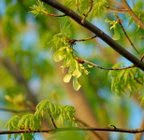

I love this Oklahoma document I found at the Library of Congress. It is hard for me to imagine in 1900 being so concerned about the loss of the forests. Of course, Oklahoma was very late on the scene, the Eastern forest had been devastated 100s of years previously. The Ouchita's in Oklahoma and Arkansas were hit hard in the mid to late 1800s. The Forest service has a great history on that.
Most interestingly in the document is the Indian's role in the Oklahoma Prairies. This really underscores my new understanding of the Oklahoma Prairie system. It was not a system due to natural processes, but a system dominated by a thriving Indian Culture.
- Desoto travels through the Ouchita's in 1542 and finds large fields of maize (corn) and flourishing Indian communities.
- The French arrive in the 1670s.
- No Indian populations left? Disease?
- The practice of burning forest and prairie to encourage large grazers to come and eat the new green spring growth was practiced by the Indians. Sometimes the prairie and forest would burn over 100 miles.
- So, my question: If the there was flourishing Indian communities that were devastated and culturally crippled. Did the large grazers increase in numbers due to lack of hunting?
- It seems to me that the herds of Buffalo that Lewis and Clark experienced in 1802 or 1804 had to be a result of Indian cultivation.
 The Ouchita's today. They are managed (meticulously) by the Forest Service. They are logged, views are maintained, cleared and staged.
The Ouchita's today. They are managed (meticulously) by the Forest Service. They are logged, views are maintained, cleared and staged.My point: The prairies are a man made landscape.
Yes there always were large grasslands, but probably not like the pictures of Oklahoma City and Norman in 1900. It took fire to kill all of those trees. So now we find ourselves in a landscape in central Oklahoma dominated by trees. Oklahoma does not have the deep agricultural roots of Europe. It is a young state and has been more dominated by cattle and failed farms. The layers of land use in Oklahoma are very few.
The Indian cultures manipulated the landscape and when the great prairies are mentioned, it is their landscape that is referred to.
The Sooners and Boomers had a much different vision. One of a more Jeffersonian attitude. They bound it with the grid iron of the survey. They divided it up in a "Democratic" method. (Depending on what side of the ethnic fence you were on.) It was then spoiled and plundered in the exploitative manner that founded the country. Trees were cut; sod was tilled; cattle introduced. The resources of land were used to sustain and garner. The excess of resource were considered as equity and treated as such.
As has happened repeatedly through our history disaster struck. Time and chance, drought and depression. Oklahoma literally blows away. With it the Sooners and Boomers are evicted by the very thing they came for--the land.
Conservation--the years of planting and damming.
Now we find ourselves in an era where the Oklahoma land is not appreciated. It is not understood. We don't have a general maintenance policy. The prairies of the Indian cultures has dissappeared, with only small remenants remaining. The farmer still struggles with most of the land too unproductive to sustain single families. We are not at risk of our soil blowing away.
Where is the landscape of Oklahoma going? I don't want to return to the treeless prairie of 1900, but what about open space? Are farms important? Should we struggle (because it will be a struggle) to honor them, maintain them and celebrate them. What about our forest? What about our forests that make up our rural areas. There are remnants of virgin forest scattered all up the east side of the Sante Fe Rail line that runs up through Purcell, Norman, Oklahoma City and Edmond. Are they worth saving? Should we place a higher value on them? Should we consider them as part of our past culture? Do they reflect times past? What about our forest that took over the fields of the Grapes of Wrath period? The elm and hackberry and mulberry?
So if landscape is a palimpsest. What does the graphical representation of OKC look like on actual paper? How would I do that? Instead of going backwards, what is the next layer going to look like on the land? What needs erased and what needs saved?
jlw



